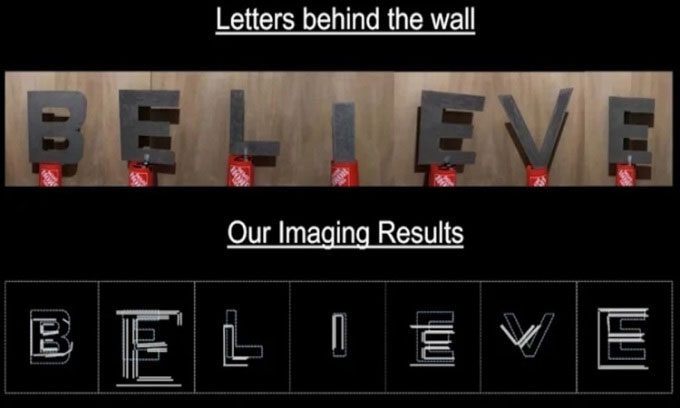A research team at the University of California, Santa Barbara, has developed a new method that can simulate images of static objects behind walls using WiFi.

The word BELIEVE placed behind a wall (above) and the image captured using WiFi (below). (Photo: UC Santa Barbara)
The motion-sensing technology using WiFi signals has shown many promising results. However, the challenge of applying similar technology to static objects arises from their lack of movement. To overcome this challenge, the research team used the English alphabet as a static object. Their method, called Wiffract, utilizes the radio waves from WiFi transmitters to conduct experiments.
Wiffract is developed based on Geometric Theory of Diffraction (GTD) by Joseph Keller, which exploits the signatures left by edges on a receiving grid. When waves collide with the edges, wave peaks emerge, known as Keller cones, according to GTD. This interaction corresponds not only to sharp, visible edges but to all surfaces. The researchers installed the receiving grid near the edges. The reflected rays left different signals on the receiving grid, allowing the team to determine the images of the objects they were monitoring.
“We then developed a mathematical model, using cone signals to infer the outline of the edges,” said Yasamin Mostofi, a professor at the University of California, Santa Barbara. This allows for the representation of WiFi images of the English letters through the wall.
In their experiment, the research team placed the characters of the word “BELIEVE” behind a wall to read using WiFi. The final results revealed a clear image of the letters. “Wiffract not only easily identifies the characters but also captures the details of the letters very well. Wiffract enables reading through walls using WiFi for the first time,” the research team concluded.
Mostofi and colleagues conducted 30 experiments capturing uppercase English letters. After obtaining the images, the researchers could enhance the images using refinement tools. Various applications of Wiffract include crowd analysis, person recognition, health monitoring, and smart spaces.
- Even if humanity goes extinct, these 3 types of traces will last almost forever!
- A horrifying custom: To be recognized as a man, you must endure being bitten by ants to the point of “living in agony” 20 times
- The mystery of the tiny creature that can live up to 100 years and eats no more than 10 times




















































